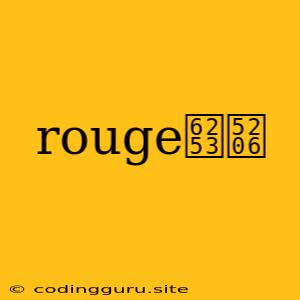What is Rouge Score?
Rouge score, short for Recall-Oriented Understudy for Gisting Evaluation, is a widely used metric for evaluating the quality of text summarization. It is a set of metrics that measure the overlap between words or phrases in a generated summary and a set of reference summaries. It is a recall-based metric, meaning it focuses on how well the generated summary captures the important information from the original text.
Why Use Rouge Score?
- Objectivity: Rouge score provides a quantitative measure of the summary's quality, allowing for objective comparisons between different summaries.
- Simplicity: It is relatively easy to implement and calculate, making it a popular choice for researchers and developers.
- Relevance: It directly measures the overlap between the generated summary and the reference summaries, making it a good indicator of how well the summary captures the key information.
How Does Rouge Score Work?
Rouge score calculates the overlap between the generated summary and the reference summaries based on different n-gram units:
- Rouge-N: This metric measures the overlap of n-grams (sequences of n words) between the generated summary and the reference summaries. For example, Rouge-1 counts the overlap of unigrams (single words), while Rouge-2 counts the overlap of bigrams (two-word sequences).
- Rouge-L: This metric measures the longest common subsequence (LCS) between the generated summary and the reference summaries. It focuses on the length of the longest sequence of words that appears in both texts.
- Rouge-S: This metric measures the number of skip-bigrams (two-word sequences with a gap) that are common between the generated summary and the reference summaries.
Calculating Rouge Score
To calculate Rouge score, you need:
- Generated Summary: The text that you want to evaluate.
- Reference Summaries: One or more human-written summaries that are considered to be high quality.
The calculation typically involves:
- Tokenization: Break down the generated summary and reference summaries into individual words or tokens.
- N-gram Extraction: Extract n-grams (unigrams, bigrams, etc.) from both the generated summary and the reference summaries.
- Overlap Calculation: Calculate the number of n-grams that are shared between the generated summary and each reference summary.
- Averaging: Average the overlap scores across all reference summaries.
Interpreting Rouge Score
Rouge score is typically expressed as a percentage, with a higher score indicating a better summary.
- Rouge-N: Higher Rouge-N scores suggest that the generated summary contains a higher proportion of the same n-grams as the reference summaries.
- Rouge-L: A higher Rouge-L score indicates that the generated summary has a longer common subsequence with the reference summaries, suggesting a better overall sentence-level structure.
- Rouge-S: A higher Rouge-S score implies that the generated summary has a higher proportion of skip-bigrams in common with the reference summaries, highlighting its ability to capture semantic relationships.
Example
Generated Summary: The cat sat on the mat.
Reference Summary: The furry feline was sitting on the soft mat.
Rouge-1 Score: 3/5 = 0.6 (The words "cat", "sat", and "mat" are shared between the generated summary and the reference summary)
Rouge-2 Score: 1/3 = 0.33 (The bigram "sat on" is shared between both summaries)
Rouge-L Score: 3/5 = 0.6 (The longest common subsequence is "The cat sat on the mat")
Tips for Improving Rouge Score
- Focus on Key Information: Ensure your summary captures the most important facts and ideas from the original text.
- Use Varied Sentence Structure: Avoid overly repetitive sentences to improve Rouge-L scores.
- Consider Synonyms: Use synonyms for words that appear in the reference summaries to increase overlap and improve Rouge-N and Rouge-S scores.
- Use High-Quality Reference Summaries: Use multiple reference summaries from different sources to ensure that your evaluation is robust.
Conclusion
Rouge score is a valuable tool for evaluating text summarization systems. By providing a quantitative measure of summary quality, it helps developers and researchers understand the strengths and weaknesses of their models. While Rouge score can be a useful metric, it is important to remember that it is just one measure of quality. It is often helpful to consider other metrics, such as human evaluation, to get a comprehensive understanding of summary performance.
